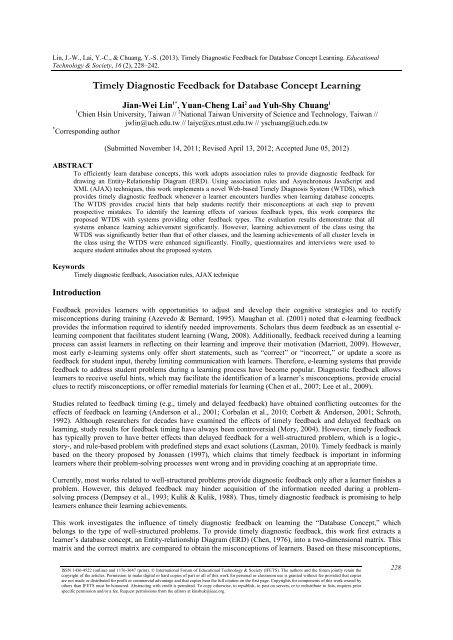Download Complete Issue in PDF - Educational Technology & Society
Download Complete Issue in PDF - Educational Technology & Society
Download Complete Issue in PDF - Educational Technology & Society
You also want an ePaper? Increase the reach of your titles
YUMPU automatically turns print PDFs into web optimized ePapers that Google loves.
L<strong>in</strong>, J.-W., Lai, Y.-C., & Chuang, Y.-S. (2013). Timely Diagnostic Feedback for Database Concept Learn<strong>in</strong>g. <strong>Educational</strong><br />
<strong>Technology</strong> & <strong>Society</strong>, 16 (2), 228–242.<br />
Timely Diagnostic Feedback for Database Concept Learn<strong>in</strong>g<br />
Jian-Wei L<strong>in</strong> 1* , Yuan-Cheng Lai 2 and Yuh-Shy Chuang 1<br />
1 Chien Hs<strong>in</strong> University, Taiwan // 2 National Taiwan University of Science and <strong>Technology</strong>, Taiwan //<br />
jwl<strong>in</strong>@uch.edu.tw // laiyc@cs.ntust.edu.tw // yschuang@uch.edu.tw<br />
* Correspond<strong>in</strong>g author<br />
(Submitted November 14, 2011; Revised April 13, 2012; Accepted June 05, 2012)<br />
ABSTRACT<br />
To efficiently learn database concepts, this work adopts association rules to provide diagnostic feedback for<br />
draw<strong>in</strong>g an Entity-Relationship Diagram (ERD). Us<strong>in</strong>g association rules and Asynchronous JavaScript and<br />
XML (AJAX) techniques, this work implements a novel Web-based Timely Diagnosis System (WTDS), which<br />
provides timely diagnostic feedback whenever a learner encounters hurdles when learn<strong>in</strong>g database concepts.<br />
The WTDS provides crucial h<strong>in</strong>ts that help students rectify their misconceptions at each step to prevent<br />
prospective mistakes. To identify the learn<strong>in</strong>g effects of various feedback types, this work compares the<br />
proposed WTDS with systems provid<strong>in</strong>g other feedback types. The evaluation results demonstrate that all<br />
systems enhance learn<strong>in</strong>g achievement significantly. However, learn<strong>in</strong>g achievement of the class us<strong>in</strong>g the<br />
WTDS was significantly better than that of other classes, and the learn<strong>in</strong>g achievements of all cluster levels <strong>in</strong><br />
the class us<strong>in</strong>g the WTDS were enhanced significantly. F<strong>in</strong>ally, questionnaires and <strong>in</strong>terviews were used to<br />
acquire student attitudes about the proposed system.<br />
Keywords<br />
Timely diagnostic feedback, Association rules, AJAX technique<br />
Introduction<br />
Feedback provides learners with opportunities to adjust and develop their cognitive strategies and to rectify<br />
misconceptions dur<strong>in</strong>g tra<strong>in</strong><strong>in</strong>g (Azevedo & Bernard, 1995). Maughan et al. (2001) noted that e-learn<strong>in</strong>g feedback<br />
provides the <strong>in</strong>formation required to identify needed improvements. Scholars thus deem feedback as an essential elearn<strong>in</strong>g<br />
component that facilitates student learn<strong>in</strong>g (Wang, 2008). Additionally, feedback received dur<strong>in</strong>g a learn<strong>in</strong>g<br />
process can assist learners <strong>in</strong> reflect<strong>in</strong>g on their learn<strong>in</strong>g and improve their motivation (Marriott, 2009). However,<br />
most early e-learn<strong>in</strong>g systems only offer short statements, such as “correct” or “<strong>in</strong>correct,” or update a score as<br />
feedback for student <strong>in</strong>put, thereby limit<strong>in</strong>g communication with learners. Therefore, e-learn<strong>in</strong>g systems that provide<br />
feedback to address student problems dur<strong>in</strong>g a learn<strong>in</strong>g process have become popular. Diagnostic feedback allows<br />
learners to receive useful h<strong>in</strong>ts, which may facilitate the identification of a learner’s misconceptions, provide crucial<br />
clues to rectify misconceptions, or offer remedial materials for learn<strong>in</strong>g (Chen et al., 2007; Lee et al., 2009).<br />
Studies related to feedback tim<strong>in</strong>g (e.g., timely and delayed feedback) have obta<strong>in</strong>ed conflict<strong>in</strong>g outcomes for the<br />
effects of feedback on learn<strong>in</strong>g (Anderson et al., 2001; Corbalan et al., 2010; Corbett & Anderson, 2001; Schroth,<br />
1992). Although researchers for decades have exam<strong>in</strong>ed the effects of timely feedback and delayed feedback on<br />
learn<strong>in</strong>g, study results for feedback tim<strong>in</strong>g have always been controversial (Mory, 2004). However, timely feedback<br />
has typically proven to have better effects than delayed feedback for a well-structured problem, which is a logic-,<br />
story-, and rule-based problem with predef<strong>in</strong>ed steps and exact solutions (Laxman, 2010). Timely feedback is ma<strong>in</strong>ly<br />
based on the theory proposed by Jonassen (1997), which claims that timely feedback is important <strong>in</strong> <strong>in</strong>form<strong>in</strong>g<br />
learners where their problem-solv<strong>in</strong>g processes went wrong and <strong>in</strong> provid<strong>in</strong>g coach<strong>in</strong>g at an appropriate time.<br />
Currently, most works related to well-structured problems provide diagnostic feedback only after a learner f<strong>in</strong>ishes a<br />
problem. However, this delayed feedback may h<strong>in</strong>der acquisition of the <strong>in</strong>formation needed dur<strong>in</strong>g a problemsolv<strong>in</strong>g<br />
process (Dempsey et al., 1993; Kulik & Kulik, 1988). Thus, timely diagnostic feedback is promis<strong>in</strong>g to help<br />
learners enhance their learn<strong>in</strong>g achievements.<br />
This work <strong>in</strong>vestigates the <strong>in</strong>fluence of timely diagnostic feedback on learn<strong>in</strong>g the “Database Concept,” which<br />
belongs to the type of well-structured problems. To provide timely diagnostic feedback, this work first extracts a<br />
learner’s database concept, an Entity-relationship Diagram (ERD) (Chen, 1976), <strong>in</strong>to a two-dimensional matrix. This<br />
matrix and the correct matrix are compared to obta<strong>in</strong> the misconceptions of learners. Based on these misconceptions,<br />
ISSN 1436-4522 (onl<strong>in</strong>e) and 1176-3647 (pr<strong>in</strong>t). © International Forum of <strong>Educational</strong> <strong>Technology</strong> & <strong>Society</strong> (IFETS). The authors and the forum jo<strong>in</strong>tly reta<strong>in</strong> the<br />
copyright of the articles. Permission to make digital or hard copies of part or all of this work for personal or classroom use is granted without fee provided that copies<br />
are not made or distributed for profit or commercial advantage and that copies bear the full citation on the first page. Copyrights for components of this work owned by<br />
others than IFETS must be honoured. Abstract<strong>in</strong>g with credit is permitted. To copy otherwise, to republish, to post on servers, or to redistribute to lists, requires prior<br />
specific permission and/or a fee. Request permissions from the editors at k<strong>in</strong>shuk@ieee.org.<br />
228

















